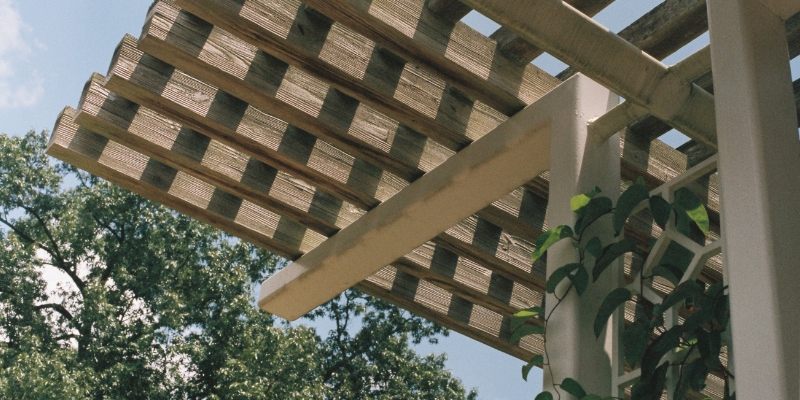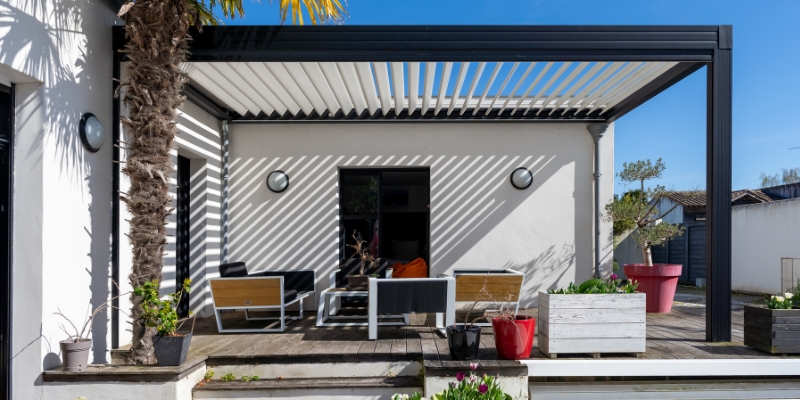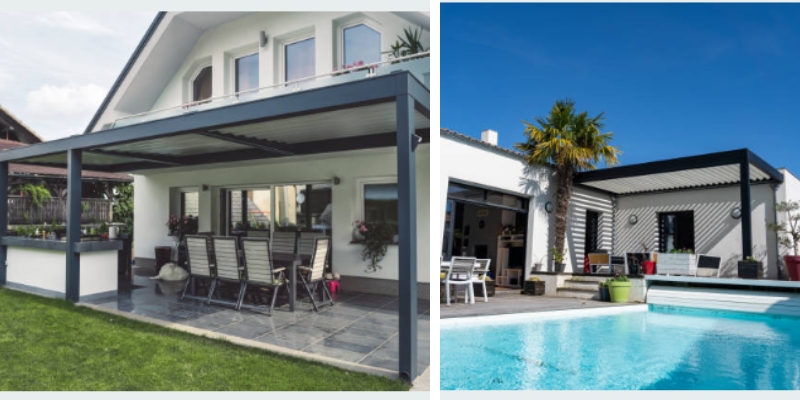
Anchoring a pergola traditionally involves drilling, a process that’s not only time-consuming but also requires considerable preparation and expertise. However, if you’re wondering whether it’s possible to anchor a pergola without drilling, the answer is yes.
Achieving a secure anchor point for your pergola without drilling is about ensuring enough support and extra weight are attached to the footings of each post. This approach not only saves time but also preserves the integrity of your outdoor space, be it a concrete patio, paver patio, or even a wooden deck.
Anyway, the reason that there is a greater possibility of the pergola flying away, we do not propose securing the pergola without drilling.
This article aims to guide you through various methods how to anchor your pergola structure, ensuring as much stability as possible without the need for specialized tools or altering your existing space.
Importance of Secure Anchoring of a Pergola
Whether anchoring a pergola or a gazebo structure with or without drilling, the essence of secure anchoring cannot be overstated. When it comes to installing a pergola, be it a metal gazebo or a classic pergola structure, the anchor plays a pivotal role in ensuring safety and maintaining structural integrity.
Why is this so crucial?
A pergola, unsecured, is not just unstable; it’s a safety hazard. In windy conditions, an unanchored pergola can become a danger to both people and property.
Properly secured pergola posts prevent the structure from swaying or tipping over, especially in areas prone to high winds or heavy weather conditions.
Moreover, a secure foundation extends the longevity of the pergola, safeguarding your investment and ensuring that your outdoor space remains a safe and enjoyable retreat for years to come.
5 Drill-Free Anchoring Methods For Your Pergola
For many, the idea of drilling into a concrete patio or a beautifully laid paver patio to anchor a pergola can be off-putting. Fortunately, there are several innovative methods to securely attach your pergola without the need for drilling.
These alternatives not only provide the necessary foundation but also maintain the integrity of your outdoor space.
Let’s explore some of these practical solutions that ensure stability, cater to different surfaces, and align with the overall aesthetic of your pergola.
1. Heavy Duty Concrete Planters Attached to Pergola Posts
One effective and aesthetically pleasing anchoring method is by using heavy-duty concrete planters. These planters can be securely attached to each pergola post using anchor brackets, providing a solid and stable base.
As we already mentioned, to ensure maximum stability, it’s important to choose planters that are sufficiently heavy and made from robust materials like concrete.
The placement is also key – position or attach the planters directly at the base of each post for an even distribution of weight.
2. Creating Molded Concrete Blocks for Pergola Posts
When it comes to anchoring a pergola without drilling, one effective approach is to design a mold and use concrete to secure the pergola posts. This method involves a bit of planning but offers a robust and lasting solution.
First, design a mold that fits around your pergola posts.
Next, place your pergola posts upright within the mold. Carefully pour concrete into the mold, ensuring the posts remain straight and aligned.
Smooth the concrete to your desired finish and then comes the most critical part – patience.
It’s vital to wait for the recommended drying time for the concrete to fully set. The success of this method hinges on the concrete drying while in the form.
Once the concrete is completely dry, you can remove the wooden mold. Typically, the concrete will be much stronger than the wood, making removal straightforward.
This technique not only provides a secure anchor point for your pergola but also adds a custom touch to your outdoor space as you can design the mold according to your own design preferences.
3. Using Iron Leg Weights
For those with lightweight pergolas, particularly those with thinner posts, anchoring using iron weights presents a viable solution. This technique is straightforward yet effective, especially when drilling is not an option.
Iron weights, strategically placed at the base of each pergola post, can add the necessary stability to prevent the structure from swaying under wind load or shifting in adverse weather conditions.
It’s important, however, to assess the suitability of iron weights based on the size and weight of your pergola.
The feasibility of placing enough iron weights to securely anchor a substantial structure can be challenging. In cases where the structure is more robust and demands sturdy support, alternative anchoring methods should be considered.
4. Anchoring Pergolas with Sandbags
Using sandbags is another straightforward and effective way to anchor a pergola. Sandbags provide a flexible and temporary solution for securing pergola structures and don’t require drilling.
They are particularly advantageous for temporary pergolas or in scenarios where you might need to move the structure later.
However, keep in mind that while sandbags are effective in moderate conditions, they may not provide enough stability for extremely heavy structures or in areas with strong winds.
Regular checks and maintenance of the sandbags are also necessary to ensure continued effectiveness and safety.
5. Creating a Rock and Cement Foundation for Pergola Posts
The most effective method to anchor a pergola without drilling involves using a combination of rocks, boulders, and cement.
This approach provides a solid base, ensuring your pergola stands upright and stable. Begin by digging a hole where each pergola post will be positioned. Place boulders or larger rocks at the base of these holes, creating a foundational layer.
Next, insert the pergola posts into the holes, making sure they are upright and correctly oriented. Once the posts are in place, add more boulders and cobbles around them, filling up the space in the hole.
The next step is to pour cement into the hole, surrounding the rocks and pergola posts. This cement layer will bind the rocks and the pergola posts together, creating a secure anchor point.
Allow enough time for the cement to fully set and harden, providing a strong and durable base for your pergola.
How To Maximize Stability and Safety of Your Pergola With Drill-Free Anchoring Methods

Ensuring the stability and safety of your pergola, particularly when using a drill-free anchoring method, requires attention to detail and regular upkeep.
Here are some practical tips to help you maintain a secure and stable pergola:
Ensure Even Weight Distribution
The key to a stable pergola is balancing the weight evenly across all anchoring points. Whether you’re using sandbags, concrete blocks, or heavy-duty planters, make sure that each pergola post is supported equally. Uneven weight distribution can lead to tilting or swaying, especially in strong winds, compromising the structure’s integrity.
Regular Maintenance Checks
Routine inspection of your pergola’s anchoring system is crucial. Check for any signs of wear and tear, such as cracks in the concrete surface or damage to the planters. If you’re using sandbags, ensure they haven’t deteriorated and are still providing sufficient weight. Replace or repair any components as soon as you notice issues to prevent potential safety hazards.
Manage Fabric Shade Roof Awnings
If your pergola has a fabric shade roof or an awning, be mindful of how it’s used during windy conditions. It’s advisable to retract or open the fabric awning when expecting high winds. This reduces pressure on the anchoring system, as the fabric can catch wind like a sail, exerting additional force on the anchors. Proactively managing the awning in this way helps prevent undue stress on your pergola’s structure, ensuring its longevity and safety.
Conclusion
By exploring various drill-free anchoring methods like heavy-duty concrete planters, sandbags, molded concrete bases, and iron weights, you can find a solution that suits your pergola’s specific needs and your outdoor space.
Remember, the key to a stable and safe pergola lies in choosing the right anchoring method, ensuring even weight distribution, and conducting regular maintenance checks. Whether you’re anchoring on a concrete patio, a wooden deck, or directly on the soil, these non-invasive techniques offer a practical way to secure your pergola while preserving the integrity of your outdoor area.


